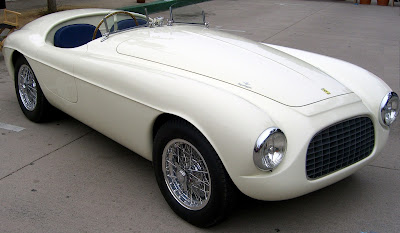When I was a grade school kid there were two cars in my neighborhood that I really wanted. One was a brand new black 1959 Citroen DS-19 owned by one of two mysterious sisters who lived across from the Catholic church; they'd traded in an almost equally new-looking black 1934 Chrysler Airflow for it, and that seemed a pretty appropriate move to me. Around that time, I floated away on a hydropneumatic cloud when a substitute teacher treated me to a ride in her own gray DS. Perhaps I'd finally turned in a decent book report to deserve this; I can't remember. The other automotive lust magnet was a metallic blue AC Ace Bristol roadster which was almost too pretty to behold. Now and then I'd spy it parked near the bank; perhaps it was owned by a banker. I didn't have anything to trade for a ride in that car, but I would've given anything except my dog…
The Ace, first shown by AC in 1953 and in production until 1963, was a kind of lucky accident. Race car builder John Tojeiro had been building specials with alloy bodies closely modeled on the Ferrari Barchettas by Touring Superleggera. AC (for Auto Carriers) had been building (mostly by hand) a traditional-looking saloon powered by their long-stroke overhead cam six, designed by John Weller and dating from 1919…
One Tojeiro special which caught the eye of AC management was a slightly larger car powered by a Lea-Francis engine, and then a Bristol unit. AC adopted the car as a prototype, and it appeared at the Earls Court show with a transplanted 2 liter AC engine developing all of 85 hp. It's the last black & white photo below. Other than the full-height windshield on the Ace, the main change from Touring's Ferrari Barchetta body (top photo below) is the elimination of the stiffening rib formed into the alloy and linking the wheel arches. This line was, however, featured in the early Tojeiro Bristol (#76) and Tojeiro MG (#62).
Tojeiro's cribbed design was soon updated by raising the headlights, imparting the famous "mustache" line (hand-hammered out of aluminum) around the grille, which was now tilted forward at the top edge. At the same time, AC raised the boot for more space, and angled the lower edge forward. The happy effect was to give the car its own character, an external sign of the modernity underneath the skin; on launch in 1954 it was the first English production sports car* to feature four-wheel independent suspension. The car found popularity with English club racers, and the demand for more power led in 1956 to the availability of the 2 liter Bristol six, with its odd cross-pushrod design allowing hemispherical combustion chambers and decent power despite the long stroke. With this engine, the car gained 35 to 45 hp depending on state of tune, and while lighter and faster than any production Bristol model, it was also a lot cheaper. Disc brakes became optional, and the revitalized car now found success with racers across the pond…
In a move calculated to appeal to Jaguar and even Aston Martin clientele, AC introduced a fastback coupe around the same time. The resulting Aceca featured a glassy, hinged hatch for access to the luggage area, and Italianate styling which also seemed a reference to early 50s Ferraris, in this case the ones by Vignale. It was available with both the AC and Bristol engines, and a handful of late ones were made with a Ford six.
Just when it seemed that Bristol's decision to stop production of its famous old six signaled the end of the party for AC, racer Ken Rudd got the idea to substitute his tuned version of the 2.6 liter Ford Zephyr inline six, now with up to 170 hp. All of the three dozen roadsters built with the Ruddspeed Ford engine featured handsomely revised styling, with the curved windshield and lower snout shown below.
But while Ken Rudd and the Hurlock brothers at AC deserve credit for the idea of popping a Ford engine into their car in 1962, someone else gets credit for finally making AC famous. In that same year, a Texan working out of a SoCal garage was scheming a Ford transplant for the same car, but this time with a V8. That, however, is a story for another chapter…
*Errata:
The Lagonda 2.6 Litre, built from 1948 to '53, also had 4-wheel independent suspension, but it was a 4-passenger touring car. The first version of this post credited the AC with being the first British production car of any kind with this feature. Though it took 6 years for Lagonda to sell 510 cars, it was a production car by British standards. Apologies to Aston Martin Lagonda...
Photo credits:
Top: pinterest.com
2nd: AC Cars, on myntransportblog
3rd: wikimedia
4rh: laluneta.com.ar
4rh: laluneta.com.ar
5th: AC Cars
6th: co1000.com
7th: momentcar.com
8th: hemmings.com
9th: wikimedia









No comments:
Post a Comment